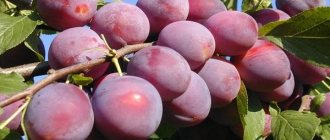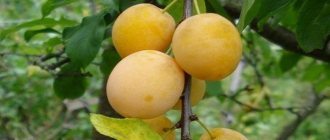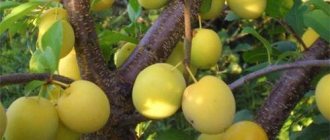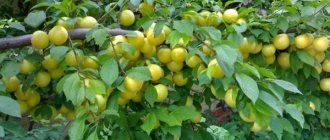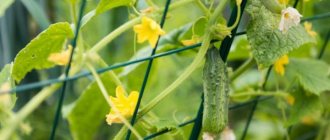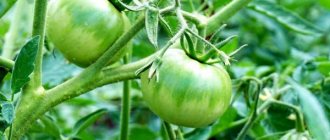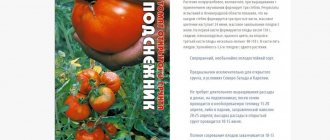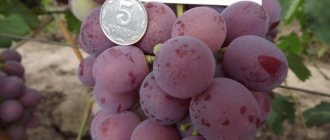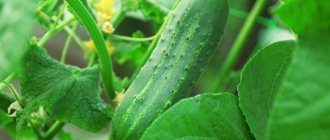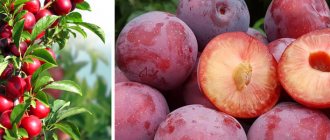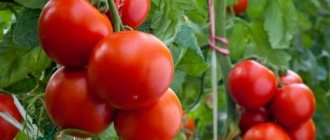Cherry plum “Cleopatra”, despite the name, which refers to antiquity, is a fairly young variety. An application for permission to plant was submitted in 1997, and already in 2004 it was added to the State Register as recommended for planting in the Central region of Russia. Originator – Moscow Agricultural Academy named after K.A. Timiryazev represented by breeders A.V. Isachkina, N.V. Agafonova, B.N. Vorobyov.
Gardeners note that the variety grows well and bears fruit successfully in the Volga region, the Urals, and the Far East.
History of selection
Today there is a variety of cherry plum varieties, which makes it difficult for gardeners and summer residents to choose. In this case, it is necessary to take into account the specific planting conditions, characteristics of the variety, its characteristics and preferences. The peculiarities of cherry plum are that it is a delicate fruit that is not susceptible to cold weather. The history of this cherry plum variety began with its breeding at the Moscow Agricultural Academy. K.A. Timiryazev from a seedling from free pollination of the Kuban Comet variety in 1991, and thanks to its breeding, gardeners and summer residents received a variety that is persistent, unpretentious and frost-resistant. Below is a photo of the Cleopatra cherry plum during the harvest season.
Characteristics
The characteristics of the cherry plum variety Cleopatra lie in determining the main factors that many gardeners pay attention to before carrying out the process of planting this variety on their own garden plot. Before planting, it is advisable to consult or take the advice of experienced gardeners.
Drought resistance, winter hardiness
This plum variety belongs to the winter-hardy species. The tree can withstand air temperatures of about 40 0 C below zero. If the temperature is low enough, the branches will be moderately exposed to the cold, but the shoots will be slightly exposed. Spring frost damage to flower buds is also mild. As for drought resistance indicators, this level has above average indicators.
Pollination, flowering period and ripening time
The cherry plum variety Cleopatra belongs to the group of self-sterile plants, so it requires an additional pollinator. When choosing a domestic type of cherry plum, you need to understand that it will not be a suitable option as a pollinator. Among the optimal pollinators for the Cleopatra cherry plum, one can distinguish any type of hybrid plum or a species called Chinese plum.
The flowering process is quite early, as it occurs around mid-May. The fruits also ripen very early, around mid-August or early September.
Productivity and fruiting
The first harvest may occur within 3-4 years, but this variety is characterized by high fertility. In the first year of harvest and subsequent years, you can collect from 25 to 40 kg from one tree. The harvested crop can be stored at average temperature for 1-1.5 months. The maximum lifespan of this cherry plum variety is 45-60 years.
Area of application of fruits
Hybrid cherry plum Cleopatra belongs to the dessert species. It is used as the main ingredient in the preparation of jams, juices, compotes, soufflés and preserves. It is consumed raw or can be frozen for the winter.
Resistance to diseases and pests
This type of cherry plum variety is quite resistant to pests and all kinds of diseases, since they practically do not affect it. Hole spot, which affects leaves, has never been observed in this species; fruit rot was found in one in a hundred cases. Aphids and the widespread codling moth are also very rare, especially if the plant care is correct and of high quality.
Advantages and disadvantages
- quality characteristics of fruits;
- high productivity and early pregnancy;
- resistance to all kinds of damage;
- excellent drought and winter hardiness.
The most common shortcomings identified by professional gardeners:
- self-sterility;
- resistance to diseases is average.
Self-fertile cherry plum varieties
Most varieties of plums and cherry plums are themselves sterile. For high-quality pollination, it is necessary to plant at least two trees of different varieties, but blooming at the same time. However, several cherry plum varieties are self-pollinating and can be planted individually.
Cleopatra
Partially self-fertile cherry plum, ripens in August. Fruits without interruption. In the presence of cross-pollination, the yield increases by 2-3 times. The trees are medium-sized (3-4 m). The first fruits are produced in the 4th year of planting. A tree lives up to 60 years. The variety has high immunity to pests and diseases.
The fruit has a red-purple skin. The pulp is dense, red. Weight – 30 g. Suitable for various purposes, including freezing. Heat/drought resistance is average. From 25 to 35 kg of cherry plum are collected from the tree. Cherry plum picked from a tree can be stored at normal temperatures for up to 1.5 months.
Cleopatra
Cleopatra is a late, partially self-fertile cherry plum variety. If there is cross-pollination, the yield will be 2-3 times higher.
- Productivity is average, fruiting is stable.
- The taste of the fruit is sweet and sour, weight 30 - 35 g. ripen in September.
- The tree is medium-sized, 3 - 4 meters high.
- Early fruiting is average, usually the first harvest occurs in the fourth year after planting.
- Winter hardiness is high; this cherry plum variety is recommended for growing in the Moscow region and the middle zone.
- Good disease resistance.
To obtain a high yield, it is recommended to plant 1 - 2 other varieties of cherry plum or Chinese plum next to Cleopatra.
Growing
The Cleopatra variety has a long growing season, which distinguishes it from cherry or plum trees.
Seedlings and the tree itself tolerate frost differently. When planting seedlings in the spring, by autumn they will not be able to develop sufficiently. Thus, the seedlings become defenseless against frost.
Already a year after planting, the cherry plum begins to bear fruit, producing frequent and high yields.
It is important to choose the right soil for planting Cleopatra. If the groundwater level is elevated, soaking may occur. It can be eliminated by installing drainage or planting a seedling on a mound.
Cherry plum grows well on:
- black soils;
- floodplain light loams;
- chestnut;
- sandy loam.
Cherry plum needs good sunlight and protection from the wind. In shaded areas and areas exposed to strong gusts, the seedling will grow and develop slowly, and the fruits will be small and lacking in sugar. It is important to take this fact into account when choosing a planting site or to leave sufficient distance between trees.
The tree must be planted in a hole 60x80 cm. Depth - no more than 55 cm. A peg is inserted into the hole to tie the tree. Next, they are covered with the top layer of excavated soil, which includes phosphorus and potassium fertilizers and humus. It is not recommended to apply fertilizers containing nitrogen, lime and fresh manure when planting.
In addition to this procedure, irrigation with fertilizers is carried out:
- potassium (60 g);
- phosphorus (200 g);
- wood ash (500 g).
One of the formative stages is pruning. Young branches that have stopped growing are shortened by 15-20 cm. Anti-aging circumcision is performed after 7-9 years.
The growing season for cherry plum lasts longer than for plums or cherries.
For planting to be successful, the planting hole must be dug 60x80 cm in size and about 50 cm deep. During planting, a peg is inserted into the hole to tie up the tree. The root is sprinkled with soil from the hole mixed with fertilizers containing phosphorus and potassium and humus. Potash fertilizers can be replaced with wood ash. Experienced gardeners do not recommend applying fertilizers containing nitrogen, lime and fresh manure when planting.
Formative pruning plays an important role. After the growth of young shoots stops, they are pruned by 15-20 cm. Trees that have reached 8 or 10 years of age are rejuvenated in the same way as other fruit crops.
Cherry plums are not only tasty, but also healthy berries, and if you follow simple recommendations, you will be able to enjoy the juicy fruits grown with your own hands.
Description and characteristics
Modern Cleopatra is a wonderful cherry plum grown in the gardens of many gardeners in the country. The description of the variety should start with the main characteristics.
The crop begins to bear fruit 4 years after planting. Productivity is average, fruiting is constant. The tree is partially self-fertile, so to get a good harvest, it is recommended to plant 1-2 other varieties of cherry plum in the neighborhood. Productivity in the presence of cross-pollination doubles or even triples. Fruit harvesting occurs in September. Winter hardiness is high. Also cherry plum, named Cleopatra, has strong immunity to diseases.
Externally, the crop is a medium-sized tree - 3 to 4 m high. The crown is wide-conical and medium-thick. The shoots are straight and thin with brown bark. The leaves are elliptical in shape, have large serrated edges and are dark green in color. The fruits are large, smooth and round-oval in shape, the average weight of each does not exceed 37 g.
A side seam is visible on the surface of the berries. The peel is red-violet and quite dark. The top of the fruit is flat, the narrow funnel is medium in size. The stalk is small both in thickness and length. The pulp has a dense structure, it is gristly and red in color. A small stone is easily separated from the core of the fruit. The taste of the fruit is sweet, there is an obligatory sourness. The berries contain 3.1% acid, 5.5% sugars and about 9.3% dry matter.
Characteristics
- The beauty Cleopatra's pregnancy rate is quite high. Already 4 years after planting you can enjoy the delicious fruits;
- and if everything is clear with the previous characteristic, then there is some confusion with the ripening period. Numerous sources classify the variety either as early, or as middle, or even as late. This discrepancy can only be explained by growing conditions and climate. What does the State Register tell us about this: it classifies our heroine as a mid-season variety;
- The fruits do not ripen at the same time, so the harvest can be harvested within 2 weeks;
- Official sources do not provide exact data on yields. But, according to reviews, the cherry plum is medium-yielding - from 20 to a maximum of 40 kg per tree, but at the same time, which is important, the variety is characterized by stable fruiting;
- our heroine is self-sterile, which forces us to plant at least a couple of suitable varieties in the garden that bloom at the same time as her;
- The winter hardiness of the variety is very good; it is not without reason that it is recommended for cultivation in a region where fluctuations in winter temperatures are common. In addition, Cleopatra's flower buds are also resistant to early spring frosts; if damage is observed, it is minor;
- drought resistance is also quite good, above average, which makes it possible to cultivate the variety even in hot regions where there is an acute lack of moisture;
- immunity is not high enough. VNIISPK describes the relative resistance of cherry plum to major diseases;
- transportability is good. If appropriate storage standards are observed, the shelf life of the crop will be a month or even more;
- method of use is universal. Fruits are consumed in their natural form. They are also suitable for processing into jam, preserves, and compote.
Description
The tree is small in size, about 3.0 - 3.5 meters high, but not higher than 4.0. The crown is not thickened, spreading, wide-conical in shape. The shoots are erect, thin, and the bark is brown. The leaves are green, elliptical in shape, gradually tapering towards the apex, the base is wedge-shaped, the edge is coarsely serrated. The surface of the leaf blade is smooth, with a slight gloss, arched along the central vein. The petiole is uncolored, medium size.
The fruits are one-dimensional, round-oval in shape, quite large - weight 37 grams. The funnel is narrow, of medium depth, the top is flat. The side seam is shallow, but well defined and noticeable. The skin is dense, not too thick, during ripeness it becomes dark red-violet, the waxy coating is very pronounced. The peduncle is average in all respects. The pulp of the cherry plum is dense and gristly, red in color. The taste is very good, harmoniously combines sweetness and sourness. Taster rating 4.7 points on a five-point system. The stone is not very large; it is separated from the pulp by half. The fruits contain: dry matter 9.3%, sugar 5.5%, acid 3.1%.
Description of the variety of Russian plum (cherry plum) “Cleopatra”
Cherry plum variety “Cleopatra” is a medium-sized tree. The crown is wide-conical, not dense.
The fruits are large, 37 g, round-oval in shape, leveled. The side seam is noticeable and of medium depth. The color of the skin is dark red-violet, with a strong waxy coating. The top of the fruit is flat. The skin is medium thick, dense. Medium size pit, semi-detachable.
The taste of cherry plum “Cleopatra” is very good, sweet and sour, harmonious. The pulp is red, dense, gristly.
Productivity is average.
Relatively resistant to disease.
Winter hardiness is high.
The advantages of the variety are that it is a late-ripening variety, winter-hardy, and fruits of good taste.
Disadvantages of the variety : self-sterile, relatively resistant to diseases.
Description of cherry plum fruits of the “Cleopatra” variety
The fruits of “Cleopatra” are red as the main color; when ripe, the skin acquires darker, deeper tones, becoming from dark burgundy to dark purple, with a bluish waxy coating. The pulp at consumer ripeness is deep red.
The shape of the cherry plum is round-oval, fairly even, symmetrical, its average size is 37-40 grams. The stone is small, separates very well from the pulp and is easily separated.
The taste qualities of “Cleopatra” can be defined as harmonious; it optimally combines sourness and sweetness. Tasters' ratings are high; the variety is classified as dessert. The use of cherry plum is universal: the taste is perfectly revealed both fresh and frozen, great for jam, jam, soufflé, compotes or juice.
The fruits have good keeping quality and can withstand transportation well over long distances. At low temperatures in refrigerators or warehouses they can remain fresh for up to one and a half months.
The benefits of cherry plum fruit "Cleopatra"
Columnar cherry plum berries contain many vitamins and valuable microelements. It is best to eat it fresh, but you can make various preparations for the winter - jam, compote, juice, jam, marmalade. You can freeze and dry cherry plum fruits. In the Caucasus, especially in Georgia, sour tkemali sauce is prepared from cherry plum, and thin dried flatbreads are also made, which are added as a seasoning to various dishes.
The juice obtained from cherry plum has a healing effect on the body for the following diseases:
- Anemia and anemia.
- Decreased gastric secretion.
- Avitaminosis.
- Diabetes.
- Obesity.
Cherry plum care
If a lot of snow fell in winter, then in the last days of March or the first days of April it will be necessary to make grooves in the ground so that melt water does not stagnate in the area. All dead bark must be removed from the surface of the trunk and skeletal branches, and then they are washed with a solution of copper sulfate (3%). Caring for cherry plum in April includes formative and sanitary pruning, planting seedlings, treatment for prevention against various diseases and pests, grafting cuttings, digging up the soil around the plant, fertilizing with nitrogen-containing fertilizer, and cutting out root shoots.
If the winter period turns out to be little snow, and the spring period is without rain, then the cherry plum will need spring moisture-recharging watering. After a little time, the plant should be sprayed over the buds, and for this a solution of microelements is used.
Sometimes in May you have to protect cherry plums from returning night frosts. In the same month, fertilizing with complex mineral fertilizer is carried out.
Read more: How to transplant a grape cutting to a permanent place
How to care in summer
In summer, such a tree needs to be watered systematically. After this procedure, the surface of the tree trunk circle is loosened to a depth of 8 to 12 centimeters, and all the weeds will need to be pulled out. When watering, it should be taken into account that adult specimens need less water compared to young ones.
It is necessary to promptly treat the plant against diseases and pests. Also, do not forget to pinch the ends of shoots that do not have time to ripen before the end of the growing season.
If it is expected that there will be a lot of fruit, then install supports in advance. When 4 weeks have passed after the first foliar feeding of the tree, this procedure will need to be repeated again, but now the nutrient mixture should contain not only microelements, but also potassium and phosphorus.
If the plant is already bearing fruit, then in August it will need special care. The fact is that it is at this time that it feeds its fruits, and the formation of generative buds for the next year also occurs. This month, the plant needs to be well weeded and the surface of the trunk circle loosened; while watering, try to get the soil wet to the depth of the root system.
After the entire harvest is harvested at the end of September, and the foliage begins to change its color to yellow, mineral and organic fertilizers must be added to the soil for digging. Before leaf fall becomes widespread, the plant will need moisture-recharging watering, and the soil should become wet by 0.4–0.6 m.
When the planting of seedlings is finished, we need to start preparing the cherry plum for winter. First you need to clean the bark from particles that have died, and then you should whitewash the trunk and the base of the skeletal branches with lime. Next, you need to seal the existing hollows and cut out all the root shoots. Fallen leaves and other plant debris should be removed from the site and destroyed.
Cherry plum processing
In April, for preventive purposes, the tree should be treated with a solution of iron sulfate (2%) and copper sulfate (1%), this will help protect it from viral, fungal and bacterial diseases, as well as from pests. But you can spray the plant only before the sap begins to flow, otherwise the buds that have begun to open may burn. This treatment should be repeated in the autumn, when all the foliage has fallen, which will protect the cherry plum from the same problems as in the spring.
How to water
Despite the fact that such a tree is drought-resistant, it needs to be watered. If the summer turns out to be dry, then on average it may need 3 waterings: when it blooms, when the growth of the stems stops, and when the berries turn their proper color. Pre-winter moisture-recharging irrigation is carried out in October.
Fertilizer
Organic fertilizer is applied to the plant's trunk circle in the autumn, using 10 kilograms per 1 square meter. This kind of moisture-recharging irrigation should be done no more than once every 2 or 3 years. Fertilizing with mineral fertilizers is carried out every year. Before the plant blooms, in the spring it is necessary to apply nitrogen-containing fertilizer to the tree trunk circle.
In June, cherry plum needs phosphorus and potassium fertilizer. The approximate consumption rate of potassium fertilizer (potassium sulfate) is from 15 to 25 grams per 1 square meter, nitrogen fertilizer (for example, urea) is from 1 to 20 grams per the same area, and phosphorus (superphosphate) is from 40 to 50 grams. Also, in addition to these root feedings, the plant needs two foliar feedings during the season.
Wintering cherry plum
If the bush is mature, then it will be able to survive the winter without shelter. And in young specimens in the autumn it is necessary to hill up the trunk very high, and cover the surface of the trunk circle with a thick layer of mulch (humus, peat or compost). You can also mulch the soil around mature cherry plums. After snowdrifts appear, it is recommended to hill up the plant trunk with snow, and you also need to cover the trunk circle to get a good snowdrift. In this case, the cherry plum will be able to survive any frost.
Features of culture
- “Cleopatra” is a winter-hardy cherry plum, perfectly tolerating frosts down to -40 degrees Celsius, which makes it suitable for cultivation in many regions of Russia.
- Flower buds tolerate recurrent spring frosts and temperature changes, as well as drought;
- Indicators of resistance to diseases and pests are average - in general, cherry plum is not susceptible to hole spot, fruit rot and aphids are rare.
- Trees live a very long time, up to 50 years with proper pruning and care.
Crown and leaves
The trees are medium-sized, reach a height of 2-3 meters, form a wide-conical spreading crown with a fairly sparse covering of leaves. The shoots are thin, straight, brown in color. Leaf plate:
- the shape is close to an ellipsoid, with a smooth surface;
- rich green color;
- edges with jagged coarsely serrated nature.
Description of culture
Growing the presented cherry plum variety is excellent for the Moscow region and central Russia. It is also possible to grow in the north-west, the Urals, the mid-Volga region, the Southern Urals, Altai and the Far East.
Description of the cherry plum Cleopatra is a medium-sized tree, the crown is sparse and spreading, the height of the fruit ranges from 2-3 m, the shoots are thin, the leaves resemble the shape of an ellipse of dark green color. The average weight of the fruit is 37-40 g, the fruit of the tree has a round oval shape, the stone is of medium size and is separated from the pulp of the fruit. The color of the presented cherry plum is dark red-violet, with a slight waxy coating, the skin of the berry is medium thick, the taste of the collected fruit is sweet with a slight admixture of sourness.
Agricultural technology
You can plant seedlings in the garden in spring or autumn. Our heroine loves the sun, so choose a sunny area for her, preferably in the southern part of the garden. Agricultural technology does not differ from the basic rules for caring for crops in general. But, given the plant’s not very high immunity, it will be necessary to inspect the tree and carry out preventive spraying regularly.
Cleopatra deserves to be noticed. The representative of the new hybrids shows good early fruiting, bears fruit consistently, and is not afraid of frost and temperature changes. She is not picky about care. Its main advantage is, perhaps, its taste, thanks to which the fruits are often used in their natural form as a dessert. Disadvantages include insufficient resistance to disease and self-sterility. But in the first case, the situation will be corrected by preventive treatment of the trees, and the productivity and quality of the fruit will be increased with the help of a pollinator; in addition, another variety of cherry plum in the garden will allow you to compare the taste characteristics of both varieties.
Features of cultivation
The cherry plum with the beautiful name Cleopatra differs from the cherry and plum trees in its longer growing season. Spring planting does not always result in successful cultivation - due to the long growth of shoots in the fall, the seedlings may not ripen by the time of digging. In winter, they often dry out in the trench and find themselves defenseless against low temperatures.
The optimal dimensions of the planting hole are also known - 60x80 cm. Its depth should not exceed 50 cm. A peg is placed in it for subsequent gartering of the tree. A mixture of the top layer of soil obtained by digging a hole is added with humus, phosphorus and potassium fertilizers. The last two components are added in quantities of 200 g and 60 g, respectively. Instead of potash fertilizers, 0.5 kg of wood ash is sometimes added.
One of the important stages of caring for cherry plum is formative pruning. After the young shoots stop growing, they should be shortened by 20 cm. When the tree is 8–10 years old, it will need anti-aging pruning. The procedure is no different from that recommended for any fruit plants.
Choosing a landing site
Southern by nature, the plant prefers sunny areas, protected from cold winds and drafts. The best places for planting cherry plums will be the southern and southwestern parts of the garden next to buildings and fences.
Preparing for landing
In the northern regions, cherry plum is planted in the spring, after the frosts have stopped, and in the southern regions - in the fall, before the first frost.
The area should be cleared of weeds and dug up with the addition of organic matter and minerals. It is advisable to pre-mark the area, taking into account that the distance between trees should be at least 1.5 m.
Seedlings are chosen when they are one year old, preferably with closed roots. Be sure to check for signs of disease. The shoots must be alive and flexible.
What crops can and cannot be planted next to cherry plum
When planting cherry plum, you should remember that there are crops that can and that are not recommended to be planted near this variety. The ideal option would be when pollinators with the same flowering period are planted near this cherry plum variety. It is not recommended to plant stone fruit crops, which include pears and apple trees, near cherry plums. Gooseberries, raspberries and all shrub representatives can be good neighbors for this variety.
Landing
- Holes measuring 60*60*60 cm are dug a couple of days before planting. A drainage layer is laid at the bottom of the hole.
- The soil dug out of the hole is mixed with fertilizers. For one pit you need: humus (5 kg), superphosphate (40 g), potassium salt (60 g).
- The resulting soil mixture is poured back into the hole to 2/3 of the height in the form of a cone. A peg is driven into the middle of the hole to support the seedling.
- The roots of the seedling, if they are open, are first dipped in a solution of a growth stimulator for better survival.
- Place the seedling in the middle of the hole on a mound, and carefully straighten the roots. If the root system is closed, then the tree is planted in a hole by transshipment.
- Fill in the remaining soil mixture and compact it lightly, making sure that the root neck of the seedling remains flush with the ground.
- Water the seedling with lukewarm water, 10 liters per tree is enough. Be sure to mulch the root zone with a layer of 5 cm. Tie the seedling to a support.
Drought resistance, winter hardiness
This plum variety belongs to the winter-hardy species. The tree can withstand air temperatures of about 400C below zero. If the temperature is low enough, the branches will be moderately exposed to the cold, but the shoots will be slightly exposed. Spring frost damage to flower buds is also mild. As for drought resistance indicators, this level has above average indicators.
Pollination, flowering period and ripening time
The cherry plum variety Cleopatra belongs to the group of self-sterile plants, so it requires an additional pollinator. When choosing a domestic type of cherry plum, you need to understand that it will not be a suitable option as a pollinator. Among the optimal pollinators for the Cleopatra cherry plum, one can distinguish any type of hybrid plum or a species called Chinese plum.
Important! When carrying out cross-pollination, it is advisable to place in one area only those varieties that will flower simultaneously.
The flowering process is quite early, as it occurs around mid-May. The fruits also ripen very early, around mid-August or early September.
Flowering and pollination
The early fruitfulness of the cherry plum “Cleopatra” is average - the trees begin to bear fruit in the 4th year of planting. Flowering occurs in the middle period (in the second decade of May), the fruits ripen in the middle-late period - late August or early September. Harvests are consistently good from an early age - from 25 to 40 kg per tree.
To form ovaries, it is desirable to plant pollinators. You should choose varieties that bloom in the same period; in particular, varieties of Chinese plum are suitable for this.
Productivity and fruiting
The first harvest may occur within 3-4 years, but this variety is characterized by high fertility. In the first year of harvest and subsequent years, you can collect from 25 to 40 kg from one tree. The harvested crop can be stored at average temperature for 1-1.5 months. The maximum lifespan of this cherry plum variety is 45-60 years.
Area of application of fruits
Hybrid cherry plum Cleopatra belongs to the dessert species. It is used as the main ingredient in the preparation of jams, juices, compotes, soufflés and preserves. It is consumed raw or can be frozen for the winter.
Resistance to diseases and pests
This type of cherry plum variety is quite resistant to pests and all kinds of diseases, since they practically do not affect it. Hole spot, which affects leaves, has never been observed in this species; fruit rot was found in one in a hundred cases. Aphids and the widespread codling moth are also very rare, especially if the plant care is correct and of high quality.
Protection from pests of cherry plum
It is advisable to do the first protection against cherry plum pests before the start of sap flow - in early April. To spray trees and soil in the garden, 700 g of urea is dissolved in 10 liters of water. In this way, all pests wintering on the tree and under the tree will be destroyed. But such spraying will cause burns to the swelling buds if carried out a little later.
When caring for cherry plum to protect against pests in spring, summer and autumn, biological preparations such as Fitoverm, Iskra-bio, Agravertin, Healthy Garden, Aurum-S, Akarin can be used once a month to spray the garden against migrating pests. Simultaneously with protective treatments, spraying the garden with Ecoberin or Zircon solutions is effective, increasing the resistance of bushes and trees to diseases and adverse weather conditions.
Spraying against pests with Bordeaux mixture and other copper-containing preparations in the summer can lead to leaf burns. Therefore, before treating the entire crown, it is advisable to first spray one control branch. If burn spots do not appear on its leaves, you can spray the entire tree.
Wounds on trees are cleaned, disinfected with a 1% solution of copper sulfate, rubbed with fresh sorrel leaves 2-3 times at intervals of 10 minutes and covered with garden varnish.
Landing Features
In order for the growth process of Cleopatra cherry plum to occur normally, it is necessary to adhere to certain characteristics and rules for planting this variety, because its further productivity will depend on this.
Recommended timing
As for the recommended timing for planting this variety of cherry plum, it can be planted in the soil both in the autumn (September-October) and in the spring (April-May).
Important! If this is a southern region, then this process is best carried out in the autumn.
Choosing a suitable location
It is advisable to plant in the most southern parts of the plots, since the fruit loves the sun. You should not try to place the seedling under the large crowns of other trees, as it will not have enough sunlight in the future. The presence of groundwater in the planted area will be a big plus. Cherry plum will grow well and bear fruit on black soil, chestnut and sandy soils.
What crops can and cannot be planted next to cherry plum
When planting cherry plum, you should remember that there are crops that can and that are not recommended to be planted near this variety. The ideal option would be when pollinators with the same flowering period are planted near this cherry plum variety. It is not recommended to plant stone fruit crops, which include pears and apple trees, near cherry plums. Gooseberries, raspberries and all shrub representatives can be good neighbors for this variety.
Selection and preparation of planting material
To plant this cherry plum fruit, you will need to purchase a ready-made 1-2 year old seedling in a container and immediately transplant it into a prepared place. It is important to inspect the seedling for damage to the bark and roots; if necessary, trim the roots for better grafting in a new place.
It is recommended to buy seedlings in special gardening nurseries or stores; it is not recommended to buy them from hand or on the road due to the likelihood of acquiring game or other fruit.
Landing algorithm
For planting, a hole is required (dimensions 60x80 cm, depth 50 cm).
Lower the tree into the hole, with a tied peg for proper growth, cover it with a little soil and compact it.
Prepare fertilizer from half the soil, humus in an amount of 4-5 kg and 15 g of various fertilizers, which should be poured into the hole.
After installing the tree in the hole, fill it with freshly dug soil.
Pour 1-2 buckets of water around the seedling and mulch the ground.
When planting several seedlings at the same time, leave a distance of 3-4 meters between them.
Subsequent care of the crop
Subsequent care of the planted cherry plum Cleopatra consists of the following constant actions: the soil should be loosened and weeds should be removed. The shoots are pruned every spring to prevent the crown from thickening.
In the first year after planting the Cleopatra cherry plum, no fertilizing is done. Feeding should be done in the 2nd year and beyond. For feeding you need to use urea or ammonium nitrate, according to the following recipe: 1-2 spoons per 10 liters of water for one tree.
In subsequent years, fertilizing must be done 2-3 times during the season. It is correct to fertilize at the beginning of the flowering season. After applying fertilizers, do not forget to mulch the soil.
Advantages and disadvantages
This universal type of stone fruit crop combines the high productivity and hardiness of the classic cherry plum with the large-fruited size and excellent taste of plum fruits. It is also valued by gardeners for the opportunity to obtain fruits that have not only a pleasant taste and aroma, but also a presentable appearance. The crop tolerates frost well, so it is cultivated in areas in the middle zone and the Moscow region. Disadvantages include self-sterility and average resistance to diseases.
Cherry plum 'Cleopatra'
Latin name: prunus cerasifera 'kleopatra'
Main genus: Cherry plum
| Fruit size |
|
| Fruit shape |
|
| Fruit color | |
| Winter hardiness |
|
| Decoration of plants and fruits |
|
| Flower size |
|
| Brush characteristics |
|
| Berry/truss separation |
|
| Nut kernel size |
|
| Blush (cover color) |
|
| Fruit pulp color | |
| Density and character of the pulp (fruit/bush/yag) |
|
| Fruit aroma |
|
| Frost resistance (fruit/bush/yag) |
|
| Drought resistance (fruit/bush/yag) |
|
| Beginning of fruiting after planting |
|
| Ripening period (fruit/bush/yar) |
|
| Consumer maturity |
|
| Productivity (fruit/bush/yag) |
|
| Fruit shedding |
|
| Remontant |
|
| Self-pollinating/self-fertile |
|
| Purpose of fruits (fruit/bush/yag) |
|
| Taste of fruits (fruit/bush/yag) |
|
| Soil pH requirements (fruit/bush/yag) |
|
| Shelter for the winter (fruit/bush/yag) |
|
| Soil type (fruit/bush/yar) |
|
| Disease resistance (fruit/bush/yag) |
|
| Resistance to pests (fruit/bush/yag) |
|
| Habitus (fruit/bush/yag) |
|
| Growth form |
|
| Crown density |
|
| Thorns, thorns |
|
| Vitamin content (fruit/bush/yag) |
|
| Keeping quality of fruits (fruit/bush/yag) |
|
| Cultivation region by origin (fruit/bush/yar) |
|
Expand all properties
Description of the plant:
Cherry plum 'Cleopatra' is a seedling from free pollination of the 'Kuban Comet' variety. Received from the Moscow Agricultural Academy named after. K.A. Timiryazev in 1991. Accepted for state variety testing in 1997. Authors: A.V. Isachkin, N.V. Agafonov, B.N. Vorobiev.
The variety is recommended for testing in the Central region.
Dimensions and growth form:
Cherry plum 'Cleopatra' is represented by medium-sized trees. The crown is wide-conical, not dense.
Flowers and fruits:
The fruits are large, 37 g, round-oval, even. The side seam is noticeable and of medium depth. The color of the skin is dark red-violet, with a strong waxy coating. The funnel is narrow, of medium depth. The top of the fruit is flat. The skin is medium thick, dense. The peduncle is of medium length and thickness.
The pulp is red, dense, gristly. The taste is very good, sweet and sour, harmonious. The stone is medium-sized, semi-separable.
Precocity, ripening time, yield:
The precocity of cherry plum is assessed as average. The variety is universal, self-sterile. Late ripening. Productivity is average.
Winter hardiness:
Disease resistance:
The Cherry plum variety 'Cleopatra' is relatively disease resistant.
Reviews of cherry plum Cleopatra
Vera Stanislavovna Petrovets, Belgorod. New varieties of cherry plum are winter-hardy. But one of the features of cherry plum is its rapid growth. Some advise shortening strong growth shoots so that they have time to ripen. But there are experts who dispute this method. In spring, the buds may also freeze slightly. Otherwise, this culture is very attractive. It begins to bear fruit 3-4 years after planting. Fruiting is annual and abundant. Relatively resistant to pests and diseases. Tolerates close standing waters.
Oleg Efimovich Malakli, Bryansk. I live in the southern region. About 10 years ago, in the spring, I was given 2 seedlings of the Cleopatra cherry plum (Russian plum). Until now, cherry plum annually produces a fairly high yield and does not suffer from anything. It tolerates spring frosts well.
Sources
- https://fermilon.ru/sad-i-ogorod/derevya/alycha-kleopatra.html
- https://dachnyuchastok.ru/vybiraem-sort-alychi/
- https://ferma.expert/rasteniya/derevya/sliva/sorta-alychi/
- https://plodovie.ru/derevya/alycha/kleopatra-24649/
- https://sortoved.ru/alycha/sort-alychi-kleopatra.html
- https://kvetok.ru/rastenie/alycha
- https://HozGround.guru/ploddev/slivy/kleopatra/
- https://sornyakov.net/trees/alycha-kolonovidnaya.html
[collapse]
Pruning cherry plum
Spring time is ideal for pruning cherry plums, and not only amateur gardeners, but also experts think so. In March or April, before the buds begin to swell, formative and sanitary pruning is carried out, since in these months the plant does not yet experience strong sap flow. If you are late with pruning, and the buds have already begun to open, then it is better to leave this procedure until the next spring.
In some cases, pruning is also done in the summer, but it should be corrective and insignificant.
Trimming Features
There are several types of pruning, namely: thinning, rejuvenating, sanitary and shaping. During sanitary pruning, all unnecessary branches are removed. This pruning is done when necessary, except in winter. As a rule, in spring or summer, thinning pruning is carried out, in which all stems and branches are cut out, which do not allow the rays of the sun to reach the ripening fruits located in the thick of the crown.
Formative pruning has a positive effect on the formation and ripening of fruits; also, if the plant’s crown is formed correctly, this will greatly facilitate its care, prolong its life and strengthen its immunity. In order for the cherry plum to live longer, and for its old branches to be replaced by new ones, timely rejuvenating pruning is necessary.
Spring pruning
This plant can be shaped like a bush or tree with a cup-shaped crown. If the winter hardiness of the variety you have chosen is not very high, then it is best to grow such a plant as a bush; for this, the seedling is pruned at a height of 15 to 30 centimeters from the ground surface. There should be 5 or 6 branches left on this segment, which should be shortened to 50 centimeters.
Read more: Northern sweet grapes description of the variety, method of planting and care
Having used the guy ropes, they must be moved to a horizontal position (as far as possible). It is good to keep such bushes under a snowdrift in winter, which will prevent freezing and a long recovery period in the spring after this. Such bushes will bear fruit quite abundantly.
The trunk can reach a height of 0.4–0.5 m, this will allow the lower skeletal branches to be protected from severe frosts with snow in winter. However, some gardeners prefer to form a standard, the height of which reaches 0.8–1.2 m; they explain this by the fact that if the plant has a low standard, then when the snow cover begins to melt and the snowdrifts settle, this can lead to injury and deformation of small branches, which can cause wounds on the cherry plum.
If such a plant is grown as a tree, then it is recommended that it form a sparsely tiered crown. In this case, the crown is formed in the shape of a bowl, from 5 to 7 main branches should remain on the plant, and the remaining ones are cut into a ring. In the first year, during pruning, it is necessary that only 3 branches remain above the trunk, which should be placed along the trunk at a distance of 15 to 20 centimeters from one another, and you need to choose those extending from the trunk at an angle of 45–60 degrees, and also between They should form an angle of approximately 120 degrees.
In the last days of March or the first days of April, formative pruning is carried out on young specimens, while mature trees require thinning and sanitary pruning. To do this, you need to cut off all damaged and dried branches and stems, and thickening the crown and annual branches should be cut into a ring. When the tree begins to bear fruit, there will be a significant slowdown in the growth of its stems, and the pruning procedure will become easier.
Summer pruning
In the first 2 years of life, cherry plum branches can reach 1.5–2 meters in length; therefore, they will need to be shortened to 0.6–0.8 meters. This procedure is recommended to be carried out in the summer, since branches begin to grow rapidly in the places of cuts. When this procedure is carried out, the development of new fruitful branches from the lateral buds will begin.
Autumn pruning
Pruning of cherry plums is not carried out in the autumn, as this leads to its significant weakening before wintering. If there is such a need, then when all the leaves have fallen and the tree begins a dormant period, it will be possible to cut off all the injured and dried stems. Cutting areas on large branches must be coated with garden varnish.
Cherry plums of different ripening periods
The ripening period of the crop is relevant mainly for regions with a climate that is not very suitable for gardening, where the summer is short, it gets cold quickly in the fall, and winter tends to come much earlier than indicated in the calendar.
Early
Cherry plum is considered early ripening, ripening before the 20th of July.
Niberjaevskaya early - very winter-hardy
In the State Register since 1987. A highly winter-hardy variety with good immunity. Tree up to 4 m high, crown rounded, not too thick. Productivity is high (40–50 kg), annual.
The fruits are small (15–20 g), the taste is noticeably sour, mediocre. Because of this, the variety is recognized as technical. But cherry plum makes wonderfully aromatic compotes, preserves, and jams. The burgundy skin and reddish-yellow pulp of ripe fruits provide the preparations with an attractive color; the density of the pulp prevents them from falling apart during heat treatment.
Cherry plum Niberdzhaevskaya early - a variety that is great for home canning
Found
In the State Register for the Central Black Earth and Lower Volga regions since 1993. Cold resistance is above average for the crop. The variety is early, relatively well resistant to diseases (especially clasterosporiasis), productive (up to 35–40 kg), early fruiting (2–3 years from the moment of planting). Pollinators are needed. It grows up to 3.5–4 m, the crown is slightly flattened, of medium density.
The berries weigh 26–27 g, raspberry-purple, the side seam is almost invisible. The pulp is juicy and dense, bright yellow in color, with pronounced fibers. The taste is balanced, received a rating of 4.4 points.
Cherry plum Naidyona is a fast-growing, productive variety with very good winter hardiness
Video: cherry plum variety Found
Mid-season
Such varieties have time to ripen in most Russian regions. But in the Urals and Siberia it is still better not to take risks - with cool, rainy summers, the harvest dates are shifted.
Dessert early
In the State Register since 2014, the recommended region for cultivation is the North Caucasus. It grows up to 3–4 m, the crown is not too dense, spreading. The variety is self-sterile, with good immunity. Productivity - up to 45–50 kg (in optimal conditions).
The berries weigh 31 g, with thick burgundy skin and bright yellow flesh. It is not too juicy, but the taste is good (4.5 points). The purpose of the fruit is universal; it is characterized by good transportability.
Despite the name, the early Dessert cherry plum variety belongs to the mid-season category.
Columnar
In the State Register since 2002, recommended for gardeners in the North Caucasus. The height of the tree is no more than 3 m, the crown is sparse, columnar (maximum diameter 1.5–2 m, no skeletal branches). The variety is self-sterile, highly winter-hardy, with good immunity, and annually produces 30–35 kg of fruit. The first berries are tasted in the 3rd year from the moment of planting.
Their weight is up to 40 g, the yellow skin is almost completely hidden by a burgundy blush and a bluish coating. The pulp is dense, with noticeable “cartilage”. The taste was rated 4.4 points. The berries are transportable.
Unlike columnar apple trees, “Alycha Kolonnovidnaya” is the name of a specific variety, not a group of varieties
Abundant - large fruits
In the State Register since 1969. Cultivation in the North Caucasus is recommended. Height no more than 3 m, crown sparse, “weeping”. The average yield is about 45 kg (maximum up to 60 kg). The berries are first harvested 2–3 years after planting. The variety is self-sterile, the immunity level is average for the crop. Disadvantage: relatively low drought resistance.
The berries are very large (47 g), lilac-pink, covered with a thick layer of grayish coating. The pulp is dark yellow, not particularly juicy, with fibers, the taste is not outstanding (4 points). The fruits are transportable.
Cherry plum Abundant fully lives up to its name in terms of harvest volumes
Video: fruiting of cherry plum Abundant
Late
Late-ripening cherry plum is a big risk for many Russian regions. It ripens already in September, and you can’t wait for the harvest at all.
Olenka
In the State Register since 1995, recommended for the North Caucasus. It grows up to 4 m, the crown is not too thick, “weeping”. High-yielding variety - 50–60 kg. The first fruits are harvested 3–4 years after planting. Winter and drought resistance is at an average level, immunity is good.
The berries weigh about 35 g, deep lilac. The pulp is lemon-yellow, not too juicy, with fibers. The taste is rated 4.3 points. Cherry plum does not suffer during transportation.
Cherry plum Olenka is recommended for cultivation in the North Caucasus; for the Urals and Siberia its frost resistance is insufficient
Gift to the garden giant
In the State Register since 2002, it is recognized as the most suitable for the North Caucasus. The variety is medium-late, universal, early-bearing (3rd year after planting), with good immunity. It grows to a maximum of 3 m, the crown is spherical, not particularly dense. Productivity - 40–50 kg.
The berries weigh approximately 32 g. The skin is blue-violet, the pulp is dark orange, noticeably dry, with fibers, the taste is not bad (4.2 points). Cherry plum can be stored for a long time (4–5 weeks) and is easily transported.
Cherry plum Gift to the garden giant, if removed in a state of technical maturity, can be stored for more than a month
Huck
In the State Register since 1995, recommended for the North Caucasus and Lower Volga regions. A mid-late variety with sufficient cold resistance for these areas and good immunity (with the exception of gray rot), self-sterile. It grows up to 3–4 m, the crown is rounded-flat, not particularly dense. The harvest (30–35 kg) lasts for 4–5 weeks. They begin to harvest cherry plums from the 3rd year after planting.
The berries weigh about 28 g, the skin is yellow, with a pinkish “blush”. The pulp is lemon-colored, dense, gristly. The taste earned a rating of 4.2 points. Overripe fruits do not fall off, but lose their taste and the flesh becomes mealy.
The cherry plum variety Gek, unlike its “brother” Chuk, is included in the State Register of Breeding Achievements of the Russian Federation
Video: cherry plum variety Gek
Early cherry plum
Early varieties of cherry plum begin to ripen from late June to mid-July, when there are still few fresh fruits and berries. Such fruiting periods are suitable for regions with harsh climatic conditions, where cold snaps are common in August, and there may already be frosts in September.
Table: characteristics of early cherry plum varieties
| Variety | Plant size | Ripening period | Characteristic | Note |
| Traveler | Medium height | Early | The fruits are dark red (18.5 g), sweet and sour, with a characteristic aroma and orange pulp. The bone does not separate well. Winter hardiness is high. Average disease resistance | Self-fertile |
| Nesmeyana | Vigorous | Early | The fruits are pink (30 g), juicy, sweet. Winter hardiness is good. Fruits in the 4th year | Self-sterile, may fall off |
| Tent | Low-growing | Early | The fruits are burgundy in color (40 g), sweet and sour taste. Yellow pulp with a weak aroma. Winter hardiness is good. Disease resistance is relative | Self-sterile |
| Evgeniya | Medium height | Early | The fruits are dark red (29 g), sweet and sour taste. Orange dryish pulp. Winter hardiness is good. Disease resistance is average. Begins to bear fruit in the 3rd year | – |
| Ruby | Medium height | Early | The fruits are bright burgundy (30 g), sweet. The pulp is yellow. Frost and drought resistance is good | Self-fertile |
| Victory | Medium height | Early | The fruits are dark cherry, large, tasty, with yellow flesh. Winter hardiness is good. Moderately disease resistant | – |
| Purple | Medium height | Early | The fruits are medium-sized, dark red in color, sweet and sour, with orange and juicy pulp. Average winter hardiness and drought resistance | – |
